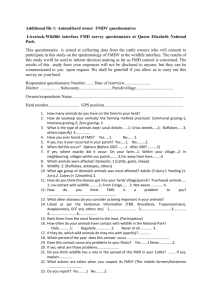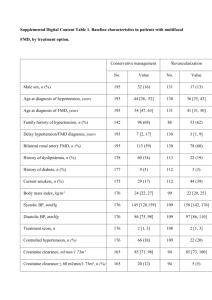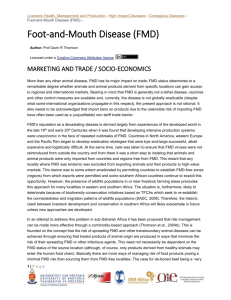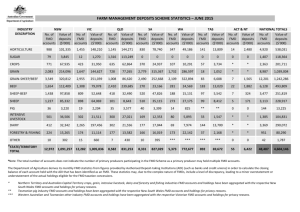Post implementation review for farm management deposits
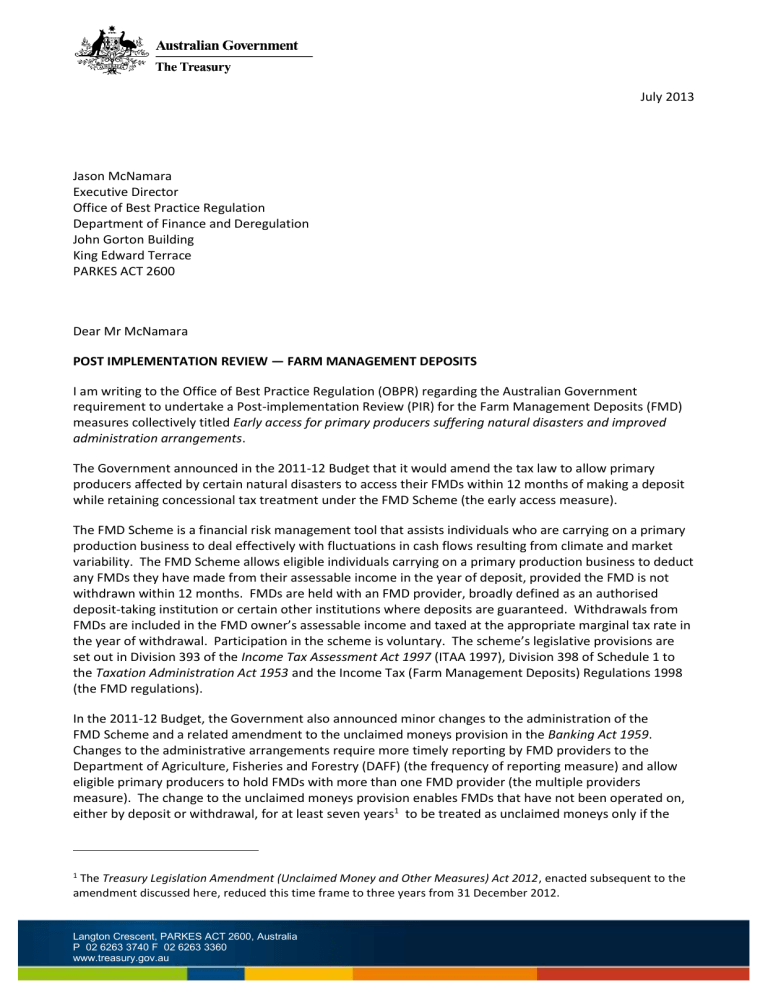
July 2013
Jason McNamara
Executive Director
Office of Best Practice Regulation
Department of Finance and Deregulation
John Gorton Building
King Edward Terrace
PARKES ACT 2600
Dear Mr McNamara
POST IMPLEMENTATION REVIEW — FARM MANAGEMENT DEPOSITS
I am writing to the Office of Best Practice Regulation (OBPR) regarding the Australian Government requirement to undertake a Post-implementation Review (PIR) for the Farm Management Deposits (FMD) measures collectively titled Early access for primary producers suffering natural disasters and improved
administration arrangements.
The Government announced in the 2011-12 Budget that it would amend the tax law to allow primary producers affected by certain natural disasters to access their FMDs within 12 months of making a deposit while retaining concessional tax treatment under the FMD Scheme (the early access measure).
The FMD Scheme is a financial risk management tool that assists individuals who are carrying on a primary production business to deal effectively with fluctuations in cash flows resulting from climate and market variability. The FMD Scheme allows eligible individuals carrying on a primary production business to deduct any FMDs they have made from their assessable income in the year of deposit, provided the FMD is not withdrawn within 12 months. FMDs are held with an FMD provider, broadly defined as an authorised deposit-taking institution or certain other institutions where deposits are guaranteed. Withdrawals from
FMDs are included in the FMD owner’s assessable income and taxed at the appropriate marginal tax rate in the year of withdrawal. Participation in the scheme is voluntary. The scheme’s legislative provisions are set out in Division 393 of the Income Tax Assessment Act 1997 (ITAA 1997), Division 398 of Schedule 1 to the Taxation Administration Act 1953 and the Income Tax (Farm Management Deposits) Regulations 1998
(the FMD regulations).
In the 2011-12 Budget, the Government also announced minor changes to the administration of the
FMD Scheme and a related amendment to the unclaimed moneys provision in the Banking Act 1959.
Changes to the administrative arrangements require more timely reporting by FMD providers to the
Department of Agriculture, Fisheries and Forestry (DAFF) (the frequency of reporting measure) and allow eligible primary producers to hold FMDs with more than one FMD provider (the multiple providers measure). The change to the unclaimed moneys provision enables FMDs that have not been operated on, either by deposit or withdrawal, for at least seven years 1 to be treated as unclaimed moneys only if the
1 The Treasury Legislation Amendment (Unclaimed Money and Other Measures) Act 2012, enacted subsequent to the amendment discussed here, reduced this time frame to three years from 31 December 2012.
Langton Crescent, PARKES ACT 2600, Australia
P 02 6263 3740 F 02 6263 3360 www.treasury.gov.au
2
FMD provider to whom the Banking Act 1959 applies is unable to contact the FMD owner after making reasonable efforts to do so (the unclaimed moneys measure).
The amendments giving effect to these measures were contained in Schedule 5 to the Tax Laws
Amendment (2011 Measures No. 7) Act 2011 and were given the Royal Assent on 29 November 2011.
The early access measure and changes to the administrative arrangements were proposed by the
Minister for Agriculture, Fisheries and Forestry on 11 February 2010. The question of whether a Regulation
Impact Statement (RIS) was required for the measures was not addressed at the time the Treasurer’s (and
Prime Minister’s) approval was sought. Treasury has since clarified the process and delineation of responsibilities with regard to the preparation of RISs with DAFF. Subsequently, the OBPR advised that a
PIR was required due to the potential impacts on FMD providers.
The Treasury and DAFF have assessed the implementation of the measures and consider them to have had a minor impact on individuals carrying on a primary production business and a minor impact on the business sector. As the impacts of these measures have not been significant and are not expected to be significant going forward, the Department of the Treasury offers you the following assessment as our PIR.
Problem
Prior to the amendments to Division 393 of the ITAA 1997 and the FMD regulations, primary producers affected by natural disasters such as floods and bushfires who chose to draw on their FMDs within
12 months of deposit and had claimed a deduction in the previous financial year’s tax return were required to amend that tax return to reverse the deduction. (They may also have been liable for general interest charges if the amended tax return resulted in a higher tax liability.) This situation created a disincentive for primary producers to access their FMDs for use in recovery activities following a natural disaster. This was contrary to the objective of the FMD Scheme of encouraging primary producers to improve their resilience by building up cash reserves that can be drawn on in times of downturn or difficulty.
When the FMD Scheme commenced in 1999, FMD providers were required to submit returns for each month to DAFF outlining: the number of FMDs held; the value and deposit date of each FMD; and the postcode, industry type, birth month and birth year of each FMD owner. These returns were due to DAFF
60 days after the end of the quarter (for example, returns for January, February and March were due to
DAFF by 30 May). In 2006, DAFF consulted with FMD providers on the reporting of FMDs.
2 Following that consultation, under a voluntary arrangement with DAFF, the majority of FMD providers agreed to submit their returns by 15 days after the end of each month.
Since 2007, the majority of FMD providers have been submitting their returns reliably within 10 days after the end of each month (that is, earlier than the agreed 15 days). However, a small number of
FMD providers continued to report in an ad hoc manner, resulting in considerable delays for DAFF in releasing aggregated FMD statistics.
Prior to the amendments to Division 393 of the ITAA 1997 and the FMD regulations, primary producers were only permitted to hold FMDs with one FMD provider, limiting their ability to seek the best return when making a new deposit.
Prior to the amendment to section 69 of the Banking Act 1959, the Australian Prudential Regulatory
Authority (APRA) issued an annual exemption order in relation to FMDs, relieving FMD providers that are authorised deposit-taking institutions from the requirement to forward certain unclaimed FMD moneys to the Commonwealth. In the absence of such exemption orders, FMD owners not operating on their FMD for seven years were at risk of having their deposit transferred to the Commonwealth through the operation of
2 DAFF met with the FMD providers that together accounted for more than 90 per cent of FMD holdings and holders at that time.
3 the unclaimed moneys provision. Achieving the appropriate policy outcome through a legislative condition for unclaimed FMDs was considered more desirable than continuing to rely on APRA’s administrative actions.
Objectives
The objective of the early access measure was to help FMD owners recover and rebuild their farm businesses following a natural disaster. The early access measure sought to achieve this by allowing primary producers who receive Natural Disaster Relief and Recovery Arrangements (NDRRA) Category C primary producer assistance to draw on their FMDs within 12 months of deposit without foregoing their deduction. The amendment was similar to the pre-existing provision under the FMD Scheme enabling primary producers in exceptional circumstances–declared areas to access their FMDs within 12 months of deposit without foregoing their deduction.
The objective of the frequency of reporting measure was to formalise the voluntary reporting arrangement in place between FMD providers and DAFF since 2006. It also aimed to enable DAFF to provide timely advice on FMD issues and analyse the latest trends.
The objective of the multiple providers measure was to provide greater flexibility to FMD owners and eliminate any disadvantage stemming from a reduced ability to negotiate competitive interest rates on new
FMDs because of the restriction of making FMDs with only one FMD provider.
In recognition of the relatively long-term nature of FMDs, the objective of the unclaimed moneys measure was to provide an additional safeguard for owners, while recognising the risk that would be associated with a broad and permanent exemption from the unclaimed moneys provision.
Impact analysis
Overall, the amendments have resulted in a minor compliance impact on taxpayers.
FMDs are available only to individuals who are carrying on a business of primary production. This impact analysis considers the impacts of these measures on FMD owners as well as FMD providers to ascertain whether there has been more than a minor impact on business for the purpose of determining the scale and scope of the PIR.
This analysis is based on the best information available at this time, noting that for the most part statistics are not yet available to support it. This is because of the relatively recent commencement of the amendments and the long lead times required to obtain taxation statistics.
At the outset it is worth providing some information about the size of the populations potentially affected by the FMD amendments. There are currently 24 FMD providers. In terms of FMD owners, current statistics are not available because all tax returns for the 2011-12 year have not yet been submitted.
However, as an indication of the size of the population, there were 39,813 FMD owners as at
30 June 2011.
3
Impacts on FMD owners
The early access, multiple providers and unclaimed moneys measures have benefited FMD owners and have had no to little compliance impact.
3 More recent statistics indicate that the number of FMD accounts at 31 March 2013 was 42,587, however this figure will include some duplication of FMD owners, given the multiple providers measure. Analysis from the Australian
Bureau of Agricultural and Resource Economics and Sciences in June 2012 suggested that around 158,000 individual primary producers are potentially eligible to hold FMDs.
4
FMD owners benefit from the implementation of the early access measure as they have access to their
FMDs to help them recover from a natural disaster while retaining their tax benefits. Under this measure, the FMD owner is no longer required to amend the prior year’s tax return to reverse the deduction claimed, reducing compliance costs for the FMD owner. The FMD owner must keep records of their receipt of the
NDRRA Category C primary producer assistance. Because these are records that the FMD owner should already be keeping, the early access measure generates very little to no compliance cost for FMD owners.
To monitor usage of the early access measure, parts have been added to the 2011-12 and subsequent tax returns supplementary question on FMD holdings, requiring the FMD owner to separately identify:
• total repayments from early access following an exceptional circumstances declaration;
• total repayments from early access following a natural disaster; and
• other repayments.
These changes to the tax return removed some of the compliance burden for FMD owners as FMD owners no longer need to aggregate these amounts when preparing their tax return. Separately identifying the amounts allows the Australian Taxation Office (ATO) to monitor usage on behalf of DAFF; tax returns lodged to date for the 2011-12 year indicate that some taxpayers have made use of the early access provisions. The changes have also had a positive impact in some cases on the time the ATO needs to process returns, as they led to several ATO system checks being refined which, in turn, has resulted in fewer queries needing to be resolved with FMD owners.
Prior to the implementation of the multiple providers measure, FMD owners seeking to benefit from better conditions with another FMD provider had to open an account with the new provider, arrange an electronic transfer of all their FMDs and close their account with the old provider (which may have incurred penalties if closed before maturity). Allowing FMD owners to hold FMDs with as many FMD providers as they choose reduces this administrative burden. In addition, primary producers are no longer restricted to making deposits with only one FMD provider and are in a better position to negotiate a higher rate of return when making a new deposit.
The unclaimed moneys measure benefits FMD owners by allowing them to leave their FMDs untouched for extended periods of time without the risk of having the deposits transferred to the Commonwealth, provided their FMD provider is able to contact them. There is an insignificant obligation on FMD owners making use of this measure that they provide the details of any change of address to their FMD provider, an undertaking that would usually be carried out in the ordinary course of changing residence. Consideration is currently being given to the treatment of deposits that are returned to an FMD owner after being transferred to the Commonwealth, as some uncertainty has recently arisen about this matter.
Again, I note that participation in the FMD Scheme is voluntary. If the ongoing benefits of the scheme did not outweigh the administrative costs of participation, the scheme would not be attractive and may not function effectively.
Impacts on FMD providers
The frequency of reporting, multiple providers and unclaimed moneys measures have had a minor impact on FMD providers.
The frequency of reporting measure impacts on FMD providers by requiring them to submit certain information to DAFF on a more timely basis. Now, rather than being required to provide monthly reports within 60 days after the end of each financial quarter, FMD providers are required to submit the same information before the eleventh day after the end of each calendar month. In practice, the impact on
FMD providers as a cohort was minor because, in 2011-12, the majority of the 24 FMD providers were
5 already voluntarily submitting their reports to DAFF on a monthly basis within 10 days of month-end, with only three smaller FMD providers not complying with the voluntary arrangement.
Since the frequency of reporting measure took effect on 1 July 2012, only one FMD provider has continued to regularly submit their reports a day or so after the eleventh day of the month. In this case, the
FMD provider is submitting their reports significantly sooner than they did prior to the implementation of the measure (on average, around four days after the eleventh day of each month in 2012-13, compared to around 48 days after the eleventh day of each month in 2011-12). The vast improvement in the
FMD provider’s timing of reports has enabled DAFF to release statistics for a month within two to three weeks of the end of each month, and provide up-to-date advice in relation to FMDs. From discussions with this FMD provider, DAFF understands their late submissions are not caused by problems preparing the data, but are due to internal planning issues, and that submission by the due date is easily achievable.
DAFF is continuing to liaise with this FMD provider before each return is due to assist them in meeting their reporting obligation and ensure that there are no impediments to the submission of their return.
Before the multiple providers measure was implemented, FMD owners were restricted to making FMDs with only one FMD provider. Although this benefited FMD providers by, in a sense, ‘locking in’ their existing customers 4 , it also limited the capacity of FMD providers to attract their competitors’ customers, thereby reducing their potential customer base. This measure has afforded FMD providers a potential increase in the pool of FMD customers without needing to undertake any additional administrative activity.
It creates an incentive for FMD providers to offer competitive interest rates to an expanded customer base.
The banking sector’s desire to increase the level of FMDs as a way of building local deposits to pay for their lending activities, rather than borrowing from increasingly expensive overseas money markets, has been reported in the media since the amendment was enacted.
5
The ATO is in the process of restructuring and revising the Annual Investment Income Report (AIIR)
(a report submitted by all financial institutions to provide the ATO with information about investment account activity) to better reflect its needs in terms of information gathering. A small number of the changes being made to the AIIR relate to the FMD amendments. The review and restructure of the AIIR was prompted by a number of legislative changes in past years. It provided the ATO with the opportunity to improve data collection relating to FMDs, both broadly and in relation to the FMD amendments.
Changes would have been made to the AIIR irrespective of whether or not the FMD amendments were made. Accordingly, it is reasonable to conclude that only a small but unquantifiable portion of the cost to
AIIR reporters to accommodate the changes to the AIIR may be attributed to the FMD amendments.
The restructure, which commenced with the current AIIR update and will be phased in over several updates, will provide significant benefits to both the ATO and AIIR reporters in terms of responsiveness and reporting efficiency, and will enable the AIIR to be changed at a lesser cost to accommodate future legislative changes or data collection requirements. Improvements to the data collection arrangements in relation to FMDs will also assist compliance monitoring. These benefits should offset the initial financial cost of the establishment of the necessary systems. In addition, it should be noted that the extra information being collected in the revised AIIR is already captured in the FMD providers’ systems (and in some cases is already being reported to DAFF), but is not currently reported to the ATO.
The implementation of the unclaimed moneys measure has had minimal impact on FMD providers that are authorised deposit-taking institutions because it requires them to forward unclaimed FMD moneys to the
Commonwealth only in situations where, after a specified period of time (currently three years), they are unable to contact the owner of the FMD after making reasonable efforts to do so. Any impact of making contact with FMD owners is nil or minor because other legislation or conventions (such as the Corporations
Act 2001 and Code of Banking Practice) and/or contractual agreements (such as the terms and conditions
4 Customers were not, strictly speaking, ‘locked in’ as they were able to transfer their FMDs in their entirety from one
FMD provider to another, however there were minor administrative disincentives for this, as outlined earlier.
5 For example, Marshall, A, 11 June 2012, ‘Banks want your money’, The Land.
6 of banking products) already require authorised deposit-taking institutions to contact or disclose information to deposit owners at regular intervals. Such regular contact or disclosure would meet the
‘making reasonable efforts to contact’ condition.
Some uncertainty has arisen in a small number of cases in relation to both FMDs and first home saver accounts under the First Home Saver Accounts Act 2008 (the requirements of which were used as a precedent for the FMDs unclaimed moneys provision) as to whether the requirement poses a legal obligation on relevant FMD providers to contact FMD owners. Treasury has provided guidance on the requirement and will continue consulting with the industry on this matter.
Consultation
The early access measure and changes to the administration of the FMD Scheme came about as a result of stakeholder interest and consultation. The key stakeholders are FMD providers and individuals carrying on a primary production business who hold or will in the future hold FMDs.
Following bushfires in Victoria in early 2009, the Victorian Farmers Federation called for those Victorian primary producers affected to be given an exemption from the requirement to hold their FMDs for
12 months. The Victorian Farmers Federation wrote to the Government in March 2009 outlining the case to allow disaster-affected primary producers early access to their FMDs.
DAFF conducted a review of the FMD Scheme in 2006 which drew upon expert advice.
6 The review recommended that the requirement to hold FMDs with only one FMD provider be reviewed. During consultations conducted as part of the review, a number of representatives from the banking and finance sector raised concerns with this requirement. In particular, the banking and finance sector considered this requirement to be anti-competitive, having a detrimental impact on their ability to calculate an applicant’s equity and subsequent pricing of financial services.
In February 2006, DAFF officers met with representatives from FMD providers to consult on the introduction of an improved reporting regime for FMDs. Options for a new reporting system that would simplify the reporting process were discussed. In addition, DAFF suggested shortening the time allowed for providing the statutory data, with all FMD providers indicating they could comfortably comply with a shortened reporting period, provided that a more automated reporting system was introduced. DAFF introduced the FMD Scheme database in 2008, allowing for a simpler and more automated reporting process. DAFF consulted with FMD providers at that time to educate them on correct use of the database and clarify reporting arrangements. DAFF has maintained periodic contact with FMD providers to keep them abreast of the amendments and has been available to answer queries as they arose.
Exposure draft legislation to give effect to the measures and associated explanatory materials were released for public consultation in mid-2011. DAFF alerted all FMD providers to the release of the exposure draft package. One submission was received during the consultation process and it was supportive of the exposure draft package.
The ATO consulted with FMD providers and software developers, as well as DAFF and Treasury, to ensure that the changes made to the tax return and AIIR would enable a better understanding of the use of FMDs without the need for the detailed commissioned surveys that have been undertaken by DAFF in the past.
The changes made were to collect information that already exists and to relieve FMD providers from some compliance checking. The changes will also improve the ATO’s ability to carry out compliance checking without having to ask for information from FMD owners that unpacks what they had shown on their tax
6 The 2006 FMD Review was conducted under the direction of a high level reference committee comprising officials from DAFF and related government agencies (the Treasury, the ATO, the Department of Finance and Deregulation and the Department of the Prime Minister and Cabinet), and representatives from the farm and banking industries.
7 return. Only a small portion of the overall cost to implement the changes to the AIIR could reasonably be attributed to the FMD amendments.
Overall, consultation has been comprehensive and ongoing. DAFF continued to liaise with FMD providers throughout the legislative process. As well as informing FMD providers of the release of the exposure draft package, DAFF also sent several updates on the progress of the amendments, including details of commencement following Royal Assent, and reminders about the start date of the changed reporting timeframe. Any concerns raised by FMD providers were addressed during these consultations.
The ATO has received positive feedback about the amendments from FMD owners who welcomed the opportunity to have accounts with more than one FMD provider and for early access following a natural disaster.
Conclusion
These measures have enhanced the operation of the existing scheme and generally appear to be meeting their original policy intents.
The amendment to allow early access to FMD owners following a natural disaster has been accessed by some affected primary producers, allowing them immediate access to vital funds for recovery activities.
This is consistent with the overall intention of the FMD Scheme.
The multiple providers measure removes impediments to FMD owners being able to negotiate the best possible return on their deposits. The increased flexibility provides greater inducement for primary producers to hold FMDs that will assist them to improve their resilience and self-sufficiency over the long term.
The frequency of reporting measure has had minimal impact on FMD providers while enabling DAFF to report on a more timely basis.
Likewise, the unclaimed moneys measure has had minimal impact on FMD providers while providing certainty to FMD owners about the longevity of their deposits although some concerns have arisen recently for a small number of FMD owners, which require further analysis.
Publication
The Treasury and DAFF understand that this letter fulfils the Australian Government Best Practice
Regulation requirements for a PIR and, as such, will be published on the OBPR website.
If you have any queries about this advice, please contact Jackie Dixon on 02 6263 2089 or at
Jacqueline.Dixon@treasury.gov.au.
Yours sincerely
Christine Barron
A/g Executive Director
Revenue Group
